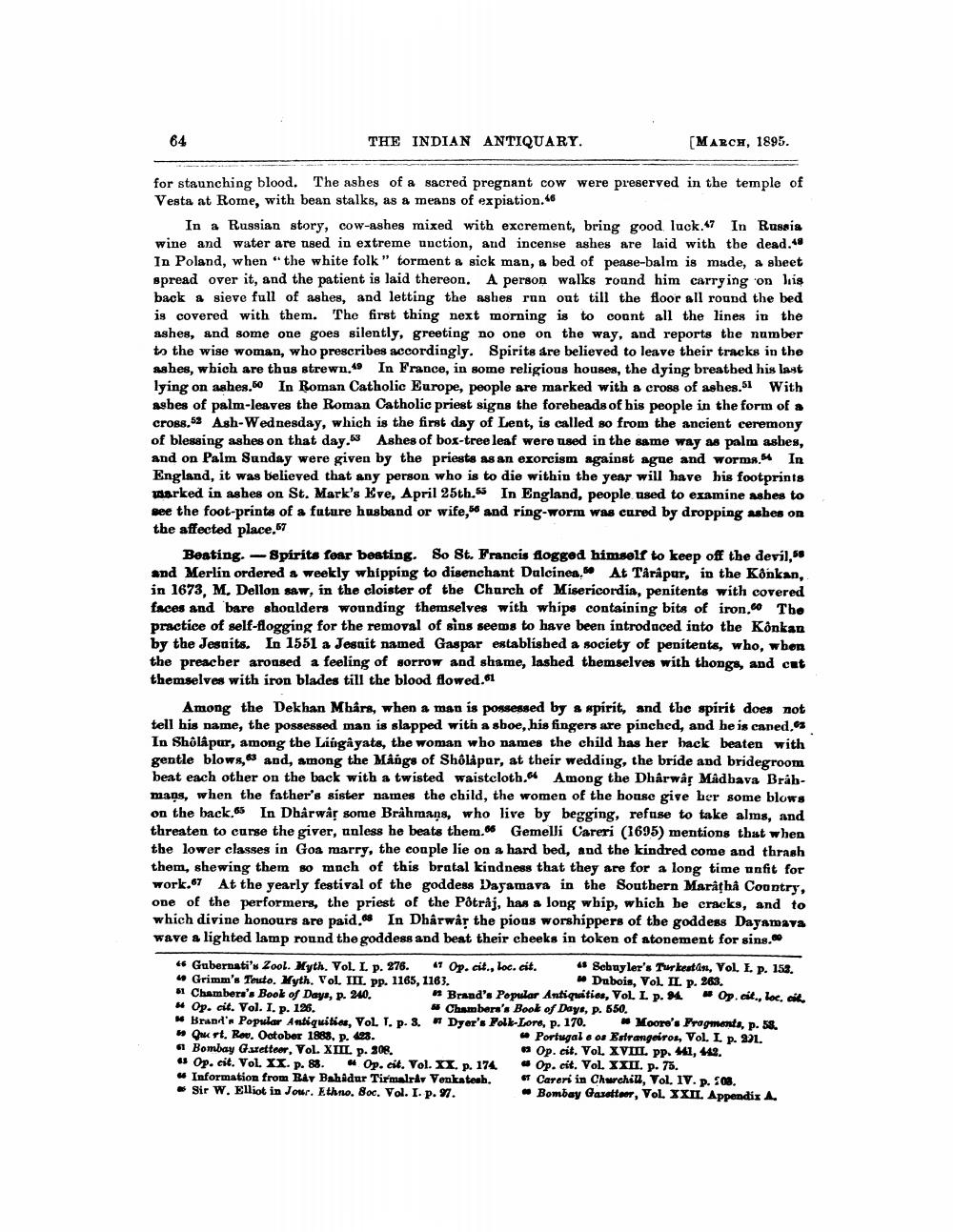________________
64
THE INDIAN ANTIQUARY.
[MARCH, 1895.
for staunching blood. The ashes of a sacred pregnant cow were preserved in the temple of Vesta at Rome, with bean stalks, as a means of expiation."
In a Russian story, cow-ashes mixed with excrement, bring good luck.7 In Russia wine and water are used in extreme unction, and incense ashes are laid with the dead." In Poland, when the white folk" tormenta sick man, a bed of pense-balm is made, a sbeet spread over it, and the patient is laid thereon. A person walks round him carrying on liis back & sieve full of ashes, and letting the ashes run out till the floor all round the bed is covered with them. The first thing next morning is to count all the lines in the ashes, and some one goes silently, greeting no one on the way, and reports the number to the wise woman, who prescribes accordingly. Spirits are believed to leave their tracks in the ashes, which are thus strewn. In France, in some religious houses, the dying breathed his last lying on ashes.60 In Roman Catholic Europe, people are marked with a cross of ashes. With asbes of palm-leaves the Roman Catholic priest signs the forebeads of his people in the form of a croBs.52 Ash-Wednesday, which is the first day of Lent, is called so from the ancient ceremony of blessing ashes on that day. 3 Ashes of box-tree leaf were used in the same way as palm ashes, and on Palm Sunday were given by the priests as an exorcism against agae and worms. In England, it was believed that any person who is to die within the year will have his footprints Iarked in ashes on St. Mark's Eve, April 25th. In England, people used to examine ashes to see the foot-prints of a future husband or wife, and ring-worm was cured by dropping ashes on the affected place.67
Beating. - Spirits foar beating. So St. Francis flogged himself to keep off the devil, 58 and Merlin ordered a weekly whipping to disenchant Dalcinea. At Tårápur, in the Konkan. in 1673, M, Dellon saw, in the cloister of the Charch of Misericordia, penitents with covered faces and bare shoalders wounding themselves with whips containing bits of iron. The practice of self-flogging for the removal of sins seems to have been introdaced into the Kônkan by the Jesuits. In 1551 a Jesait named Gaspar established a society of penitents, who, when the preacber aroused a feeling of sorrow and shame, lashed themselves with thongs, and cut themselves with iron blades till the blood flowed.
Among the Dekhan Mhârs, when a man is possessed by & spirit, and the spirit does not tell his name, the possessed man is slapped with a sboe, his fingers are pinched, and he is caned, In Sholapur, among the Lingayats, the woman who names the child has her hack beaten with gentle blows, and, among the Maógs of Sholapar, at their wedding, the bride and bridegroom beat each other on the back with a twisted waistcloth. Among the Dharwar Madbava Brabmags, when the father's sister names the child, the women of the house give her some blows on the back. In Dharwar some Brahmans, who live by begging, refuse to take alms, and threaten to curse the giver, unless he beats them. Gemelli Careri (1695) mentions that when the lower classes in Goa marry, the couple lie on a hard bed, and the kindred come and thrash them, shewing them so much of this bratal kindness that they are for a long time anfit for work.67 At the yearly festival of the goddess Dayamava in the Southern Maratha Country, one of the performers, the priest of the Pdtråj, has a long whip, which be cracks, and to which divine honours are paid. In Dharwap the pious worshippers of the goddess Dayamaya wave a lighted lamp round the goddess and beat their cheeks in token of atonement for sins.
« Gubernati's Zool. Kyth. Vol. L p. 276. 47 Op. cit., loc. cit. " Sebuyler's Turkestan, Vol. I. p. 153. 4 Grimm's Teuto. Myth. Vol. III. pp. 1165, 1163.
Dubois, VOL II. p. 263. * Chambers's Book of Days, p. 240.
Brand's Popular Antiquities, Vol. L p. 94. Op.cit., loc. cil * Op. cit. Vol. I. p. 126.
# Chambers's Book of Days, p. 550. w Brani's Popular Antiquities, Vol. 1. p. 3. Dyer's Foll-Lore, p. 170. Moore's Fragments, p. 58. QurtRou. October 1888, p. 423.
- Portugal e os Estrangeiros, Vol. I p. 271. Bombay Guretteer, Vol. XIIL. P. 306.
Op. cit. VoL XVIII, pp. 141, 142. « Op. cit. Vol. XX. p. 89. # Op. cit. Vol. IX. p. 174 Op. cit. Vol. XXII. p. 75. - Information from Bay Bahadur Tirmalriv Venkatesh. e Careri in Churchill, Vol. IV. p. 208. • Sir W. Elliot in Jour. Ethno. Soc. Vol. I. p. 9.
Bombay Garatter, VoL XXII. Appendix A.




